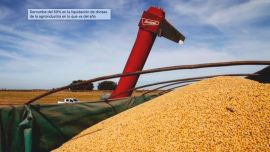The CIARA and CEC, which account for 48 percent of Argentine exports, announced on Thursday August 1 that in July companies of the sector liquidated US$2.61 billion. The data are striking because it is the same level of reserves lost during the same month by he Central Bank, which had US$29.02 billion at the beginning of July, and by the end they had US$26.39 billion.
As for agroindustrial exports, the data gain relevance as it is specified that this liquidation implied a 35.8-percent rise compared to the same month in 2023, as well as a 32.3-percent from June 2024. It is worth noting that the focus has been on the slow pace of countryside liquidation. The CIARA-CEC data seem to bring down that idea.
By comparing the first seven months of this year with the previous year, the rise was by 5.2 percent.
“The month of July has been the best of the year in terms of foreign currency income from agroexports”, they explained from CIARA-CEC. At any rate, they reminded that “grain exports continue to work with high levels of idle capacity, as is the oil industry, suffering from permanente negative margins”.
As for the pace of foreign currency liquidation, exporters recalled that “most of the foreign currency income in this sector occurs well in advance of the export, around 30 days in the case of grain exports and up to 90 days in the case of oils and protein flours exports. That also depends on the timing of the campaign and the grain in question, and thus there are no delays in the liquidation of foreign currency”, they stated.
The Central Bank lost over US$2.6 billion in reserves in July; it is worth considering that it had US$29.02 billion when the month started and when it ended that number was US$26.39 billion.
On the last day of July, the Central Bank sold reserves in the market for the sixth day running, by divesting itself of US$81 million, which means during the month it had a net sale of US$181 million, the highest since December 2023.
The causes of this drop were a challenging calendar of debt commitments which included US$2.6 billion to private bondholders, US$645 million to the IMF, US$447 million to other multilateral bodies and the first capital amortisation of the BOPREAL bonds to the tune of US$167 million. This amounted to nearly US$3.9 billion, in addition to the dollars the government had to sell to contain the foreign exchange gap.
In that setting, a private report by Portfolio Personal Inversiones (PPI) highlighted that the country’s maximum monetary authority “is losing dollars due of its intervention in the CCL/MEP blue-chip swap and financial exchange rates for the foreign exchange gap to be kept at bay”. According to their calculations, it allocated between US$253 and US$261 million in ten trade sessions for the CCL rate to collapse and the foreign exchange gap to be 37 percent.
In order to keep record of the relevance of exports in the oil-cereal complex, including biodiesel and its derivatives, the data from the INDEC statistics bureau explain that, in 2023 it contributed 50.1 percent of all exports in Argentina.
The main export product of this country is soy flour (12 percent of the total), which is an industrialised subproduct generated by this agroindustrial complex, which currently keeps a high idle capacity near 70 percent. The second top exported product last year, according to the INDEC statistics bureau, was corn (11 percent) and the third one was soy oil (6.9 percent).
--TIMES/PERFIL



















Comments